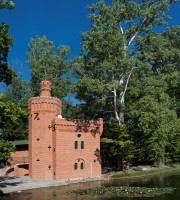The renovation and conservation of the Pump House and its environs
The Pump House is located by Lake Wilanowskie where a 17th-century geometric Baroque garden and a 19th-century English landscape park meet. Its appearance, a historic-like resemblance to a neo-Gothic pseudo-castle, and natural surroundings, with old trees, a lake and a view of the Morysin Reserve, have made it one of the main attractions of Wilanów Park. A small levée on Lake Wilanowskie for boat and gondola services for tourists further defines the role of this place in the tourist traffic within the Park.
The structure was erected in mid-19th century on the basis of a design by Enrico Marconi to serve as a water intake with underground outlets to supply fountains in different parts of the Wilanów garden with water. Currently the station does not serve its original function any more, but is provided with individual conservation protection as an important element in the historic garden and palace complex within this Baroque royal residence, entered in the register of cultural heritage monuments.
The Pump House is a free-standing building, designed on a multilateral plane, made of brick, without plaster, with four storeys and an octagonal tower housing a staircase ending with a small viewing deck. Inside, in addition to the octagonal staircase, there are rooms with an irregular arrangement. The total area of this structure is 64.8 square metres.
Due to its very poor technical condition, the Pump House was in need of in-depth renovation and conservation works to:
- disassemble the structural ceilings of the building and construct new ones,
- waterproof its existing walls,
- conserve the brickwork,
- renovate and conserve the electrical wiring,
- build a new levée and floating docks,
- repair the shoreline, develop the area and build lanes in the immediate vicinity of the pumping station, and adjust them to the arrangement of the lanes in the remaining part of Wilanów Park, including a new lane leading to the floating levée.
After the renovation and conservation works are completed, the Pump House will be able to host educational and exhibition programmes.
The renovation and conservation of the Pump House and its environs were conducted as a part of the “The revitalisation and digitalisation of Wilanów, the only Baroque royal residence in Poland” project. The Project had secured support from the European Regional Development Fund under the Infrastructure and Environment 2007-2013 Operational Programme, Priority XI “Culture and Cultural Heritage”, Activity 11.1. Protecting and maintaining cultural heritage of over-regional importance. In accordance with the adopted Project Implementation Scheme, the investment was completed by 30 September 2015. The total value of the Project: PLN 18 854 348,06. The amount of additional financing: PLN 14 912 881,37 (European Regional Development Fund: PLN 12 675 949,15, and State Budget: PLN 2 236 932,22). For more information on the Infrastructure and Environment Operational Programme please visit www.pois.gov.pl. For more information about the project please click on this link.
suggested

Project “Revitalisation and digitalisation of Wilanów, the only Baroque royal residence in Poland”
In October 2014, the Museum of King Jan III's Palace in Wilanów launched another project financed by the European Union, …

The movie “The revitalisation and digitalisation of Wilanów, the only Baroque royal residence in Poland”
“The revitalisation and digitalisation of Wilanów, the only Baroque royal residence in Poland” was probably the most difficult of all …

The conservation of the well on the courtyard
Developed in the Baroque period, the courtyard, with its characteristic division into two parts, survived until the early 19th century. …

History of the park
In the times of Jan III, construction work on the Wilanów Palace took place concurrently with the establishment of beautiful …

The restoration, reconstruction and the preparation of copies of two vases with swan heads and nods
The fragments of two hanging vases with swan heads and nods are archaeological monuments found during excavation research, known only …















